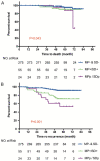Prognostic significance of micropapillary and solid patterns in stage IA lung adenocarcinoma
- PMID: 34650727
- PMCID: PMC8507014
Prognostic significance of micropapillary and solid patterns in stage IA lung adenocarcinoma
Abstract
Objective: To evaluate the value of the non-predominant micropapillary and solid patterns in prognosis of lung adenocarcinoma.
Methods: Totally 422 patients diagnosed with stage IA lung adenocarcinomas were included, and all their slides were reviewed. We compared clinicopathological characteristics and survival outcomes between MP- & SD- (both micropapillary and solid component were absent), MP+/SD+ (either micropapillary or solid component was present, but the single or combined percentage of the MP and SD was not greater than 50%) and MPp/SDp (either micropapillary or solid or the combined percentage of these two components was great than 50%).
Results: Patients with MP- & SD- had smaller tumor size (P=0.012) and lower spread through air spaces rates (P<0.001). Patients with MP- & SD- had significantly better 5-year recurrence free survival than MP+/SD+ (91% versus 70%, P<0.001) and MPp/SDp (91% versus 56%, P<0.001). The difference of RFS between MP+/SD+ subgroup and MPp/SDp subgroup was not significant (P=0.177). In the multivariate analysis, patients with MP- & SD- had a better recurrence free survival than the other two groups (versus: MP+/SD+, HR, 3.198; 95% CI, 1.537-6.653; P=0.002; versus MPp/SDp: HR, 4.981; 95% CI, 2.266-10.950; P<0.001).
Conclusions: The presence of micropapillary or solid patterns, even not predominant, was a risk factor for predicting poor recurrence free survival in very early stage lung adenocarcinoma.
Keywords: Lung adenocarcinoma; micropapillary pattern; prognosis; solid pattern.
AJTR Copyright © 2021.
Conflict of interest statement
None.
Figures




References
-
- Chang C, Sun X, Zhao W, Wang R, Qian X, Lei B, Wang L, Liu L, Ruan M, Xie W, Shen J. Minor components of micropapillary and solid subtypes in lung invasive adenocarcinoma (≤3 cm): PET/CT findings and correlations with lymph node metastasis. Radiol Med. 2020;125:257–264. - PubMed
-
- Kim M, Chung YS, Kim KA, Shim HS. Prognostic factors of acinar- or papillary-predominant adenocarcinoma of the lung. Lung Cancer. 2019;137:129–135. - PubMed
-
- Kuhn E, Morbini P, Cancellieri A, Damiani S, Cavazza A, Comin CE. Adenocarcinoma classification: patterns and prognosis. Pathologica. 2018;110:5–11. - PubMed
-
- Zhao ZR, Lau RWH, Long H, Mok TSK, Chen GG, Underwood MJ, Ng CSH. Novel method for rapid identification of micropapillary or solid components in early-stage lung adenocarcinoma. J Thorac Cardiovasc Surg. 2018;156:2310–2318.e2. - PubMed
LinkOut - more resources
Full Text Sources
